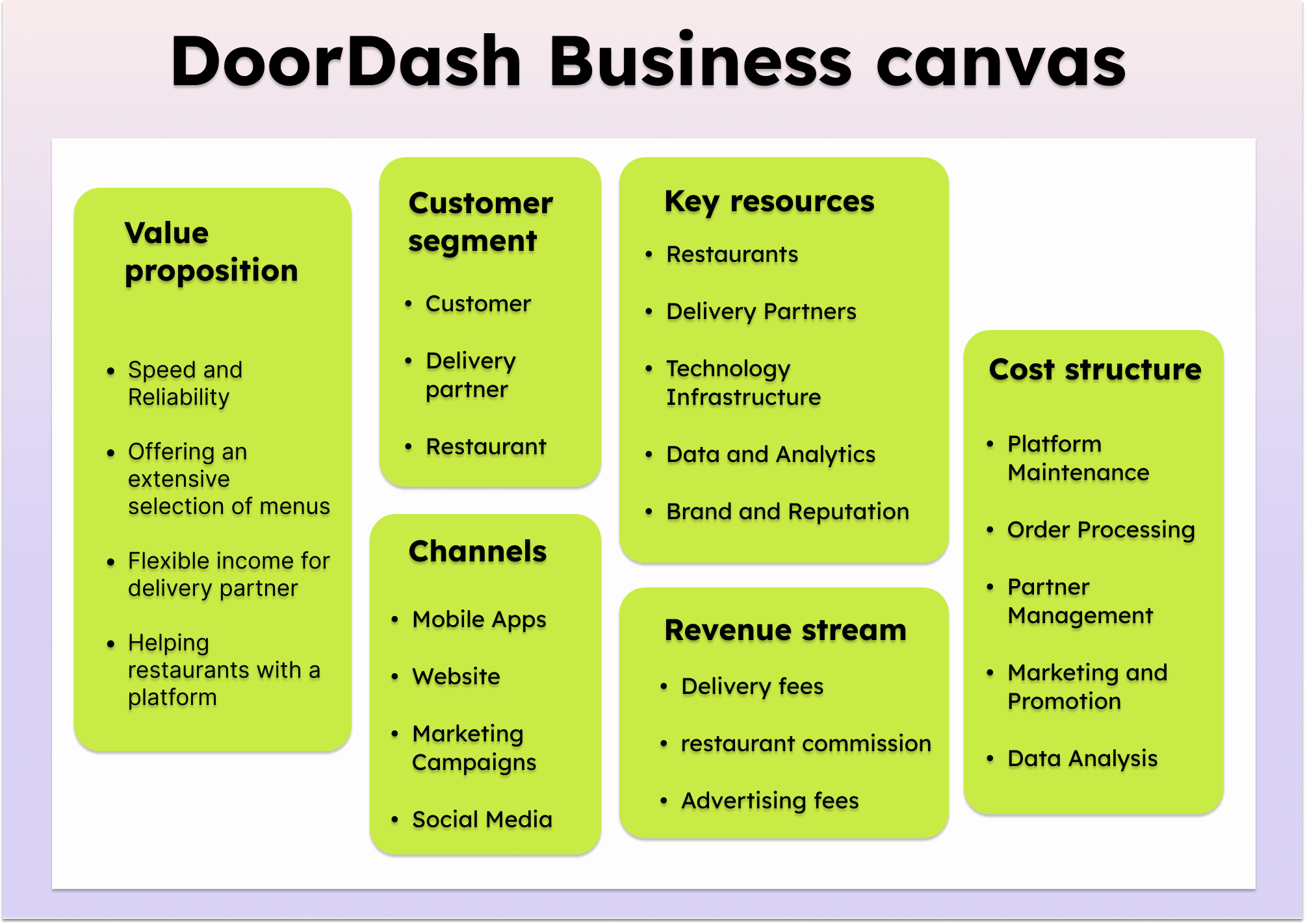
DoorDash Business Model
Explore the intricacies of the DoorDash business model in this blog. Here, we uncover their business model, future growth, revenue channel & more.
Intro to DoorDash
DoorDash, Inc., headquartered in San Francisco, is the force behind an online food ordering and delivery platform.
DoorDash rules the roost with an impressive 56% market share in the United States.
But wait, there's more! It also boasts a hefty 60% market share when it comes to delivering convenience right to your doorstep.
But, like any big player, DoorDash also does the walk with controversies.
They faced conflicts of not being crystal clear about 'how tips work,' 'allegations of messing with prices to undercut the competition,' and 'adding restaurants without the consent.'
It’s a lot. We know that!
Let’s see some data.
Let's know about DoorDash quickly
DoorDash statistics
1. Giant bugs in 2022 (Revenue)
Last year, DoorDash pulled in $6.58 billion in revenue, showing a 34% increase compared to the previous year.
That's a whole lot of meals delivered!
2. The ups and downs (Net loss)
In 2022, DoorDash faced some financial chaos, they reported an annual net loss of $1.3 billion.
It's their highest net loss to date since its existence.
Well, every journey has its downs, right?
3. Massive user base
DoorDash earned a user base of 32 million. Most of the users are from the United States.
4. Dominating the US
According to the Second Measure, DoorDash is the undisputed player in the US food delivery space, with over 60 percent of the market share.
It shows that DoorDash is the go-to choice for many.
How does DoorDash work?
1.Platform for customers
Whenever customers get to crave something delicious, well, with DoorDash, no one has to anymore.
DoorDash offers a list of menus from local restaurants and the customer can place an order with just a few taps or clicks.
Payment? It's done right through the app.
2. Restaurant Partnership
DoorDash isn't just about customers; it's also about the customer's beloved local restaurants.
They do partner with a diverse range of restaurants, from small to big-name chains.
It means that the customer gets access to an incredible variety of choices, all in one convenient place.
3. Dashers (Delivery partners)
They're the independent contractors whose role is to pick up the order from the restaurants.
Let’s see how the platform works.
Placing an order: Customers can leisurely browse through restaurant menus, place their orders, and smoothly complete payments.
Preparing the meal: The restaurants have the tools to manage the orders, keep track of their sales, and get to know the customers better.
Delivering the meal: Delivery partners head over to the restaurant, pick up the order, and deliver the meal right to the customer's doorstep.
Reviews: When the meal reaches an eater, using the phone, they can share their opinions by rating the restaurant and the delivery driver based on their experience.
DoorDash value proposition
1. Simplicity
DoorDash gives access to a range of restaurant meals to the eater's doorstep, letting the customer savor the food at their convenience is itself a unique value proposition.
2. Variety
With an impressive lineup of restaurant options, DoorDash ensures they address every sort of food craving.
3. Dependability
The Dashers and clever logistics are so sure about serving meals super hot and right on time.
4. Member perks
For DashPass subscribers, there's the added perk of reduced fees and exclusive savings, thus making the dining experience even better.
What is DashPass?
Do you know what DashPass is?
Imagine never paying a dime for delivery fees and enjoying lower service charges on every eligible order. It's what DashPass is for the eaters.
When the eaters have a DashPass subscription, they get the $0 delivery fees and reduced service fees on all eligible orders.
5. Insightful Support
DoorDash doesn't just deliver food; it offers valuable insights to restaurants, thereby helping them fine-tune their operations and create even better dining experiences.

How their future growth would be?
Despite its impressive growth in order volume, gross order volume, and revenue, DoorDash has consistently found itself in the red when it comes to profitability.
The main culprits hiding behind the curtain of lack of profitability are the substantial variable costs tied to each order, hefty spending on sales and marketing, and various operational expenses.
DoorDash surely needs a way to trim its operating losses while maintaining growth.
In a nutshell, while growth is impressive, its inability to turn a profit is only a concern here, whereas they eventually come up with a new approach to rewrite the story.
How DoorDash make money?
1. Commission fee
DoorDash charges restaurants a commission fee on every order made through its platform.
Think of it as a small percentage of the order's total.
In return, restaurants gain access to DoorDash's vast customer base and reliable delivery system.
2. Delivery fee
When ordering a favorite meal through DoorDash, they charge a delivery fee for eaters.
It varies depending on factors like how far the eaters are from the restaurant, the size of the order, and how busy things are.
3. Subscription service
DoorDash getting it's another revenue source from DashPass. This subscription method provides a steady stream of income for them.
4. DashMart
Ever tried DashMart? DoorDash's convenience store. Here, they offer household essentials, groceries, and snacks for delivery.
DoorDash likely adds a little extra to the product prices, which contributes additional revenue to them.
5. Advertising and Promotions
Restaurants and businesses can pay to get highlighted on the DoorDash platform. For that, DoorDash gives a $100 credit per store.
They charge for sponsored listings, special promotions, and other marketing services DoorDash offers.
6. Geographic Expansion
As DoorDash spreads its wings into new cities and regions, it ropes in more restaurants and customers, thereby adding more income sources and growth.
7. Additional service
DoorDash now delivers alcohol (where permitted by law) teams up with grocery stores, and collaborates with various retail businesses.
8. Dynamic pricing
DoorDash introduces dynamic pricing (or surge pricing) for delivery fees. It means they charge a bit extra when there is a rise in demand, which helps them to take advantage during busy times.
DoorDash SWOT analysis
1. Strength
DoorDash is like that popular go-to spot for food delivery.
It's got a massive piece of the share in the food delivery space, not only in the U.S. but also in other parts of the world.
Since their offering goes beyond just food, the customer can get anything, including groceries, convenience items, and even their favorite bottle of wine delivered through them.
They've teamed up with tons of restaurants and businesses and made available a world of options.
Moreover, DoorDask is known for its tech and data. They use analytics to find the best routes, predict the food demand, and make the overall experience better.
2. Weakness
Food delivery space is a bit of a battlefield.
We've got Uber Eats, Grubhub, and more. So, DoorDash has to stay on its toes to keep up.
Delivering food isn't exactly free. DoorDash has to deal with driver payments and operational costs, and it takes a bite out of their profits.
Plus, they've got to deal with regulations. You know, labor laws, worker classifications, and all sorts of local rules can make running their business a bit of a headache.
Coming to the net profit, even though they scaled their revenue to green, they can't manage to do the same for its net profit.
They're still finding ways. But we need to wait and witness the strategy they'll come up with.
3. Opportunities
DoorDash can go global. Expanding into new countries means more people getting access, which means more money in their pockets.
Subscription services like DashPass are a goldmine. They let their customer get more of their service and keep engaged with the platform.
Partnerships and joining forces with grocery stores, retailers, and other businesses could help DoorDash offer even more stuff to customers.
4. Threats
Competition is fierce. The participants are always looking for ways to outshine DoorDash.
Regulations are a headache. Labor laws are changing, and that could mess with how DoorDash runs things and how much they have to spend.
People's tastes can change, and so can their wallets. If they're not into ordering food online anymore, DoorDash could be in trouble.
Conclusion
It's clear that DoorDash has transformed the way we access and savor our favorite meals.
They didn't just make our lives more convenient but opened doors of opportunity for restaurants, businesses, and gig workers.
As DoorDash continues to evolve and respond to the needs of the eater's community, it still needs to figure out a way to turn profitable.





